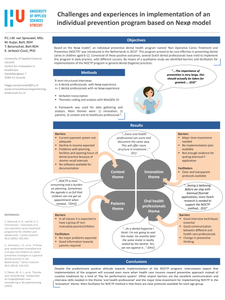DOCUMENT

Purpose: The Scored Patient-Generated Subjective Global Assessment (PG-SGA) is the only malnutrition (risk) assessment tool that combines patient-generated measures with professional-generated (medical) factors. We aimed to apply international standards to produce a high quality, validated, translation and cultural adaptation of the original PG-SGA for the Austrian, German, and Swiss setting. Methods: Analogue to methodology used for the Dutch, Portuguese, and Thai versions of PG-SGA, the ten steps of the International Society for Pharmacoeconomics and Outcomes Research’s principles of good practice for translation and cultural adaptation were followed. Comprehensibility and difficulty of the translation were assessed in 103 patients and 104 healthcare professionals recruited from all three German-speaking countries. Content validity of the translation was assessed among healthcare professionals (HCP). Item and scale indices were calculated for content validity (I-CVI; S-CVI), comprehensibility (I-CI; S-CI), and difficulty (I-DI; S-DI). Results: Patients' perceived comprehensibility and difficulty of the PG-SGA fell within the range considered to be excellent (S-CI = 0.90, S-DI = 0.90), HCP-perceived content validity (S-CVI = 0.90) was also excellent, while HCP-perceived comprehensibility fell within the high range of acceptable (S-CI = 0.87). The professional component of the PG-SGA was perceived as below acceptable (S-DI = 0.72) with the physical exam being rated the most difficult (I-DI=0.29-0.75). Conclusions: The systematic approach resulted in a high-quality validation of the German language version of the PG-SGA, that is internationally comparable, comprehensible, easy to complete, and considered relevant for use in Austria, Germany and Switzerland.
DOCUMENT
Het doel van dit praktijkonderzoek was het bepalen van de toepasbaarheid van de Actigraph om de mate van dagelijkse beweging van kinderen met een verstandelijke beperking te bepalen. De Actigraph bleek goed toepasbaar te zijn.
DOCUMENT
Reactie op 'Verpleegkundigen opleiden voor de ggz' door Koekkoek e.a., in MGV november 2013 Mijn complimenten voor Bauke Koekkoek en zijn collega’s die een fraai overzicht bieden van het opleidingsstelsel voor (GGZ-)verpleegkundigen en de ontwikkelingen daarbinnen. Gezien de complexiteit van dit stelsel hebben nog maar weinigen een goed overzicht. Zeer informatief dus! Al lezende viel mij echter ook op dat de auteurs weinig stelling nemen en richting aangeven voor de toekomst. We hebben een variëteit aan opleidingen die we moeten koesteren en continueren, zo lijkt hun conclusie te zijn. Is dit niet weer te veel polderen in ons kleine kikkerlandje? Laten we nog eens kijken naar een aantal belangrijke en actuele punten.
DOCUMENT

BACKGROUND: Since the number of heart failure (HF) patients is still growing and long-term treatment of HF patients is necessary, it is important to initiate effective ways for structural involvement of primary care services in HF management programs. However, evidence on whether and when patients can be referred back to be managed in primary care is lacking.AIM: To determine whether long-term patient management in primary care, after initial optimisation of pharmacological and non-pharmacological treatment in a specialised HF clinic, is equally effective as long-term management in a specialised HF clinic in terms of guideline adherence and patient compliance.METHOD: The study is designed as a randomised, controlled, non-inferiority trial. Two-hundred patients will be randomly assigned to be managed and followed in primary care or in a HFclinic. Patients are eligible to participate if they are (1) clinically stable, (2) optimally up-titrated on medication (according to ESC guidelines) and, (3) have received optimal education and counselling on pre-specified issues regarding HF and its treatment. Furthermore, close cooperation between secondary and primary care in terms of back referral to or consultation of the HF clinic will be provided.The primary outcome will be prescriber adherence and patient compliance with medication after 12 months. Secondary outcomes measures will be readmission rate, mortality, quality of life and patient compliance with other lifestyle changes.EXPECTED RESULTS: The results of the study will add to the understanding of the role of primary care and HF clinics in the long-term follow-up of HF patients.
DOCUMENT
Jaarlijks worden ongeveer 80.000 patiënten behandeld op de ruim 80 intensive care-afdelingen in Nederland.Op een intensive careafdeling worden vitale functies bewaakt en meestal zelfs overgenomen. Bij de meeste patiënten is voor kortere of langere tijd kunstmatige beademing noodzakelijk. Kunstmatige beademing is effectief en soms zelfs levens reddend maar is in het geheel niet zonder risico’s. Lector Critical Care Frederique Paulus gaat in haar rede in op de uitdagingen die de interprofessionele teams op de Intensive Care hebben ten aanzien van de luchtweg- en beademingszorg. Zij zal proberen te schetsen wat ‘Wij gaan goed voor u zorgen’ op een Intensive Care betekent. Het bijzonder lectoraat CriticalCare is ingesteld in samenwerking methet Amsterdam UMC locatie AMC.
DOCUMENT

‘Lifelong learning is the ongoing, voluntary, and self-motivated pursuit of knowledge for either personal or professional reasons’, zo leert ons een ’white paper’ dat door het department of Education and Science te Dublin in het jaar 2000 gepubliceerd werd en waar regelmatig naar verwezen wordt door onderwijskundigen die zich vandaag de dag met deskundigheidsbevorderingbezighouden. Maar over hoe vrijwillig en zelf-gemotiveerd de scholingskeuzenzijn die professionals moeten maken is eigenlijk maar weinig informatie voorhanden.
MULTIFILE
Nurses often have difficulties with using interdisciplinary stroke guidelines for patients with stroke as they do not focus sufficiently on nursing. Therefore, the Stroke Nursing Guideline (SNG) was developed and implemented. The aim of this study was to determine the implementation and feasibility of the SNG in terms of changes in documentation and use of the guideline in the care of stroke patients on Neurological and Rehabilitation wards, barriers and facilitators, and nurses' and auxiliary nurses' view of the implementation.
DOCUMENT
